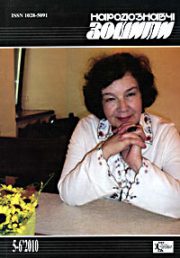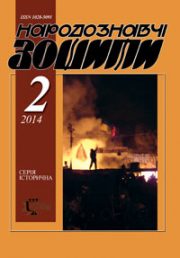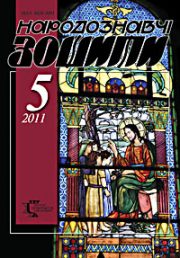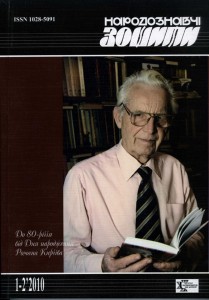2010 year, issue 1-2
Pavluk Stepan. On Steadfastness in Life ande Seience. P. 2-8
read »
Kuzmenko Oksana, Pastukh Nadiya, Kharchyshyn Olha. On Roman Kyrchiv’s Folkloristic Achievement in XXI th Century. P. 9-22
read »
Nahachevsky Andrii. To Dr. Roman Kyrchiv: Some Remembrances and Honors from Diaspora. P. 23-28
read »
Hlushko Mykhailo. Roman Kyrchiv as a Fatiguess Member of NTSh in Ukraine. P. 29-37
read »
Chornopysky Mykhailo. A Scientist with a Trait of Diligence and Uprightness. P. 38-40
read »
Pylypchuk Svyatoslav. «Sparing No Works Nor Sweats» On Roman Kyrchiv’s Frankological Studies. P. 41-46
read »
Dmytrenko Mykola. Roman Kyrchiv as a Researcher in History of Folklore Studies (To 80th Anniversary of Scholar’s Birth). P. 47-50
read »
Valyo Maria. On Forgotten Slavistic Page of Roman Kyrchiv’s Scientific Activity. P. 51-54
read »
Syavavko Euhenia. Competent, Principled, Intellectual (Word on a Scientist). P. 55-58
read »
Bilous Vira. Winged by Family Legend (To a Portret of Scientist). P. 59-64
read »
Radyshevsky Rostyslav. Polonist Roman Kyrchiv’s Harvest. P. 65-68
read »
Kyrchiv Roman. From a Patrimonial Saga. P. 69-87
read »
Khudash Mykhaili. The Origin of Nomination And Religious Mythological Functions of Ancient Russian Pagan Deity Known as Pereplut. P. 88-93
read »
Davydyuk Viktor. The Ukrainians’ Traditional Folk Mythology: The Origin of Principal Personages in Light of Palaeontology. P. 94-113
read »
Kuzmenko Oksana. On Riflemen’s Anecdote: Context — Subject – Text. P. 114-126
read »
Kozlovsky Vitalii. Folk Histotical Songs on Tartarian Invasions in Ukraine: A Problem of Chronotopology. P. 127-132
read »
Lunyo Yevhen. On Nature of Communism After Insurgent Satirical Song «Stalin Sent His Children». P. 133-145
read »
Smolyzk Oleh. Compliment and Vegetative Subject in Haivkas of Western Podillya. P. 146-151
read »
Vakhnina Larysa. On Polish Sources of Ethnographic Commission of ALL-Ukrainian Academy of Sciences. P. 152-155
read »
Franko Andriy, Franko Oksana. For The Matter of Creation of the First Ukrainian Encyclopedia (on the Basis of the Files of Personal F. Vovk’s and I. Franko’s Archives). P. 156-159
read »
Buryak Volodymyr. On Ukrainian Culture of Ethnical Consciousness (Evolutio-Historical Paradigm). P. 160-177
read »
Ivashkiv Vasyl. Additions to Themes «Panteleimon Kulish and Ostap Veresay». P. 178-181
read »
Kachkan Volodymyr. An Envoy on the Fallow Land of Word (Ivan Lypa in the Light of New Historical Documents and Materials). P. 182-202
read »
Saliha Taras. By Fire of Mine and by My Blessed Wrath. P. 203-215
read »
Sapelyak Oksana. On Activities by Society for Care of Ukrainian Emigrants. P. 216-221
read »
Malewska-Szalygin Anna. Postsocialism, Isn’t It? On Contemporary Rural Notions About Power and State (After Examples Got While Studies in Southern Poland). P. 222-228
read »
Halczak Bogdan. On Ukrainians in Poland after the Fall of Communism. P. 229-237
read »
Nykorak Olena. On Historiography and Sources of Studies in Hutsul Embroidery. P. 238-248
read »
Taras Viktoria. On Origin of Garden and Park Art of Galicia. P. 249-255
read »
Mozdyr Mykola. To a Problem of State of Furniture Craft in Galicia at Late XIX and Early XX cc. P. 256-261
read »
Motorna Volodymyr, Tatarenko Alla. On Functioning of Folklore Subjects in Fairy Novel «A Black Mill» by Y. Brezan. P. 262-268
read »
Bonkovska Olena. The Actor Truly Popular. P. 269-272
read »
Kimakovich Irina. Ukrainian folkloric anecdote as humanistic value: perspectives research. P. 273-280
read »
Bonkovska Sofiya. On Ukrainian Embroidery in Works by T. Kara-Vasylieva (Taking the Opportunity of Publication the Album «History of Ukrainian Embroidery»). P. 280-286
read »








